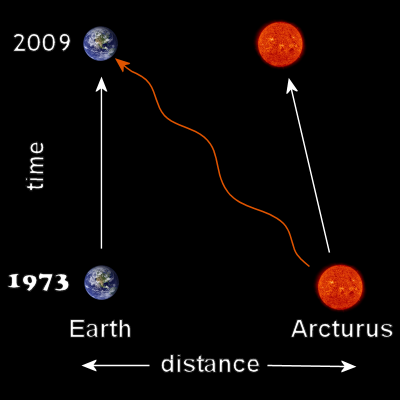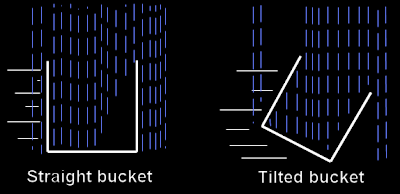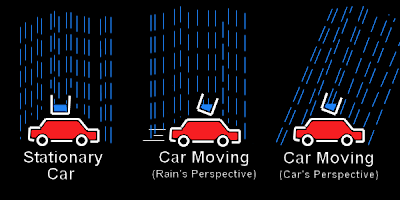When we look at the night sky and see a star or planet are we seeing it in it's exact location - or - are we seeing the light from the star or reflected light from the planet at some closer point to which the light has traveled and become visible to us?Excellent question. So, there are two reasons why we don't see a star or astronomical object where it *actually* is:
1) It's moving.
2) We're moving.
First, we'll tackle the first reason, since it's a little easier. Let's say you go outside tonight and observe Arcturus, a nice, very bright orange giant star. Now, Arcturus happens to be 36 light-years away (roughly 200 trillion miles). That means the light that you see tonight has been traveling for the past 36 years towards Earth. It left the surface of the star back in 1973, when Nixon was president, and disco was still awesome.
Now, since that time, Arcturus itself has actually been moving around the center of our galaxy - what astronomers call "proper motion". In thirty-six years, it would've moved about 1/40th of a degree on the sky (an angular distance just barely discernible to the naked-eye). However, you wouldn't see at its current location, you'd see it where it was back in 1973. Depending on whether you learn better from images than text, a diagram might be helpful here:

In the above figure, the vertical axis is time, and the horizontal axis is the distance between Earth and Arcturus. The orange squiggly arrow is the light emitted by Arcturus back in 1973, which, traveling at the speed of light, hits Earth in 2009. Notice that Arcturus moved between 1973 and 2009...but here on Earth we don't know anything about it since we're only currently receiving light from 1973. (For simplicity, I assumed that Earth isn't moving.)
Basically, we have no information about the state of Arcturus since 1973. For all we know, Arcturus could've gone supernova in 1980 (unlikely, but hypothetically speaking....) and we wouldn't know until 2016.
(Historical side note: I specifically chose Arcturus for this example because it was the first star discovered to have proper motion. In the 1600's, Edmund Halley - of Halley's comet fame - was perusing the 1500-year-old star charts of Ptolemy, and noticed Arcturus was not in the same position. The only logical conclusion was that Arcturus had moved over the eons.)
So, that's the first reason why stars are not where they appear. Now for the second, slightly more complex reason: Earth *is* moving.
Let's imagine for a moment that we're sitting in a car in a rainstorm. There's no wind, so the rain is falling straight down, presumably from a storm cloud directly above us. For some reason, we've decided to strap a bucket to the top of our car to collect rainwater...maybe we just really love the flavor of it. Whatever the reason, though, if we point the bucket straight up, we'll collect the most water.
Now, let's say we start driving really fast. It turns out that pointing the bucket straight up is not the best way to collect water - we're better off tipping it slightly in the direction of our motion. This is because if the bucket is angled it's easier for the rain to clear the the bucket's front lip and make it down to the bottom. So long as it gets inside the bucket before the back lip passes over it, it'll be collected...the following diagram of two moving buckets might help:

Notice the straight bucket produces a "rain shadow" at its front lip. Also notice the tilted bucket managed to catch some rain a moment earlier that's now covered by the back lip, but will still fall all the way to the bottom.
Now, from our perspective moving in the car, things are different. There's more rain hitting our front windshield than our back window, so we figure that rain isn't coming straight down, but at an angle. To us, our tilted bucket strategy works better because it appears the rain is coming in at an angle from a storm cloud that's both above us as well as a little ahead of us...this is the vital piece of the analogy. Again, another diagram might help:

So, instead of thinking about storm clouds, rain, buckets, and cars, let's rephrase this in terms of stars, light, telescopes, and the Earth.
If the Earth were holding still, the light from a star would come from the star's true direction (at least at the time the star emitted it). Because we're moving, though, it appears that the light comes in at slight angle from a source slightly ahead of us - just like with the rain - so we see the star as slightly ahead of us. This phenomenon is known as the "aberration of light".
Since Earth is moving around the Sun, even the Sun itself is shifted from where it "actually" is located by about 1/200th of a degree. It's not enough to notice with the naked-eye, but telescopes can easily pick up that shift.


this is sick info. great blog w/super informative posts. I have the utmost respect for the work you do. Much respect.
ReplyDelete-a concrete philospher
Mike! Thank you for taking the time not only to clarify my question but to provide such an interesting and detailed answer! I get it now! I can put my brain to use on more immediate problems -like what's for dinner
ReplyDeleteMy husband and I enjoy astronomy and are avid star watchers (we live in the country with little light pollution). We may not know What's What but it's still fun. I plan to follow your blog. Thanks for taking the time to help others with learning more about the heavens. :o) ♥ ∞
ReplyDeleteThis is a great informational blog! My uncle is an astronomer in Tucson. You should see his photos: http://theketelsens.blogspot.com
ReplyDeletei love your blog.avid follower. thanks for taking the time to answer everybody's questions. totally a big deal!!please follow my blog...you inspire me!!!
ReplyDeletehttp://sundayq.blogspot.com
Wait, I thought another factor was that gravitational forces distort the course of the light. Doesn't that play a role in this?
ReplyDeleteMike, you're great at explaining things like these. Keep it up! Your blog is my newest addiction.
ReplyDeleteRelativity. It's one aspect of physics I always loved and it's explained perfectly here. Great post all around.
ReplyDeleteDisco is still cool... and so is astronomy. Cool blog, I once applied to become a civilian astronaut. But my application must have been lost in the mail because I never got the call.
ReplyDeleteNew follower
Excellent point, Naurgul...I'm about to post a follow-up on this.
ReplyDeleteI followed you right up to the point where you showed a picture where the car's view of the rain didn't match the rain's view of the car. How can that be?
ReplyDeleteHeya Jen,
ReplyDeleteYeah, I had a feeling that part would be a bit confusing...The basic issue has to do with frame of reference.
One thing that a stationary observer outside the car and someone driving inside the car can both agree upon is that more rain is hitting the car's front windshield than the back one. Their reasons why this happens differ, though.
To the stationary observer, the rain is falling vertically straight down, but the car is moving horizontally to the right...thus more rain hits the front windshield.
To the driver inside the car, the car seems to be stationary (assuming a perfectly smooth car ride and constant speed) while the outside world, including the rain, is whizzing by horizontally to the left. For the person inside the car, more rain hits the front windshield more because the rain is moving horizontally to the left as well as vertically downwards.
Okay, I know this sounds a little counterintuitive simply because when you drive you can tell you're moving...this has more to do with the fact that no car has a perfectly smooth ride.
A better example might be when you're sitting inside a train stopped at the station and a second train pulls up alongside you and stops. As the second train begins to move again, for a moment there's an eerie feeling of vertigo where you can't tell if your train is starting to move, or if the second train is starting to move. It's only when you see the background world again that your brain can solve this cognitive dissonance. It's this movement ambiguity that's key to what I'm talking about here.
Cynthia asks:
ReplyDeleteWhen we look at the night sky and see a star or planet are we seeing it in it's exact location - or - are we seeing the light from the star or reflected light from the planet at some closer point to which the light has traveled and become visible to us?
Excellent question. So, there are two reasons why we don't see a star or astronomical object where it *actually* is:
1) It's moving.
2) We're moving.
First, we'll tackle the first reason, since it's a little easier. Let's say you go outside tonight and observe Arcturus, a nice, very bright orange giant star. Now, Arcturus happens to be 36 light-years away (roughly 200 trillion miles). That means the light that you see tonight has been traveling for the past 36 years towards Earth. It left the surface of the star back in 1973, when Nixon was president, and disco was still awesome.
I learned much from reading this blog and am impressed that the uiniverse time and space are complex phenomena not easily amenable to our perceptions oftentimes even with our refined instyruments. To our perceptions time appears in a suspended way, it seems, a "never cath cup affair."
nice
ReplyDeleteThis comment has been removed by the author.
ReplyDeleteThis comment has been removed by the author.
ReplyDeleteThis comment has been removed by the author.
ReplyDeleteThis comment has been removed by the author.
ReplyDeleteThis comment has been removed by the author.
ReplyDeleteThis comment has been removed by the author.
ReplyDeleteFantastic post.
ReplyDeleteReally enjoyed reading it and it held my attention all the way through! Keep it up.
Read my Latest Post